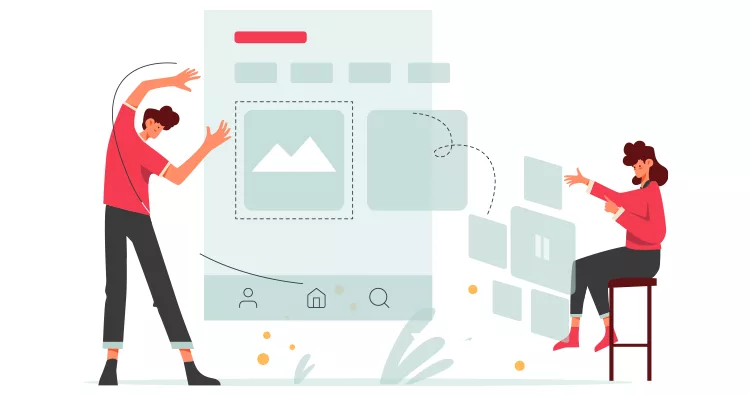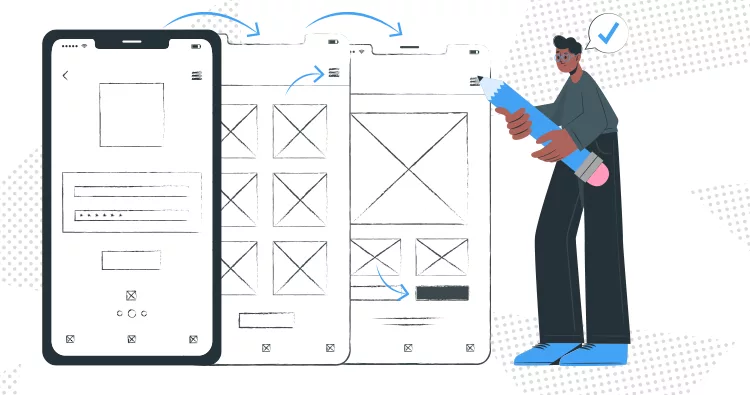When it comes to user interface (UI) and user experience (UX) design, many entrepreneurs and business owners may feel like they're in over their heads. After all, creating an appealing and easy-to-use interface for your customers is crucial for any business - but where do you start? In this blog post, we will provide an insider's guide to UI/UX design and development, shedding light on what these terms mean and how you can use them to create a successful product or service. So, whether you're just starting out or you're looking for ways to improve your existing UI/UX design, keep reading!

User experience (UX) design is a crucial element of any product development process. By taking into account the needs and expectations of users, UX designers create products that offer a seamless and enjoyable experience. In order to do this, they must consider all aspects of the product, from branding and design to usability and function. By taking a user-centered approach, UX designers can ensure that products are not only effective but also enjoyable to use. In today's competitive marketplace, UX design has become essential for any company that wants to succeed.
Within the field of UX design, there are many important principles to consider. However, we often simplify things by breaking them down into five main concepts: Empathy, strategy, usability, inclusivity, and validation. Each of these concepts is essential in its own way and should be given due consideration when designing user experiences.
1. Empathy: As a UX designer, it is important to be able to put yourself in your users' shoes in order to understand their needs and wants. Try to see things from their perspective and design accordingly.
2. Strategy: Having a well-defined strategy is critical for any successful UX project. Define your goals and objectives, as well as the approach you'll take to achieve them, before starting any work.
3. Usability: Creating user-friendly designs is essential for ensuring a positive experience. Keep usability in mind when planning and designing your user interfaces and interactions.
4. Inclusivity: Not all users are the same, so it's important to create inclusive designs that cater to a wide range of users. This helps ensure everyone can enjoy your product or service.
5. Validation: It's essential to regularly test and seek feedback on your designs to ensure they are effective and meet users' needs. Use user research, usability testing, and A/B testing to validate your designs.
By following these five main concepts, you can create successful UX designs that meet users' needs and expectations. main concepts will lead to success in UX design.

User experience (UX) design is the process of designing products that provide meaningful and relevant experiences to users. This involves understanding the user's needs and goals, and then designing the product in a way that meets those needs. Good UX design can help increase customer satisfaction and loyalty, as well as reduce churn rates. Additionally, it can help you create customer journeys that are most likely to lead to conversions or other desired outcomes. In short, UX design is important because it can have a significant impact on a company's bottom line. By understanding the user's needs and designing products that meet those needs, you can create a competitive advantage for your business.
In the world of business, customer loyalty is key. It's what keeps customers coming back, again and again. And it's important for businesses to find ways to nurture and grow that loyalty. UX designers play a role in this process, by creating stickiness for products and brands. When a product is easy and enjoyable to use, users are more likely to keep coming back. This is particularly necessary for instances where you can "try before you purchase," such as e-commerce. If your user experience is good, you'll gain user loyalty right away. Users will enjoy the ease of use of your site and will be more willing to revisit it. UX designers help to develop consumer loyalty one interaction at a time in this way.
The design of user interfaces for machines and software, such as computers, home appliances, mobile devices, and other electronic devices, with an emphasis on maximizing usability and the user experience, is defined as user interface design (UID) or user interface engineering.
The goal of user interface design is to make the user's interaction as simple and efficient as possible, in terms of accomplishing user goals (USER GOALS), without regard to the underlying technology. User interface design requires a good understanding of human cognitive and physical limitations, as well as of user goals and preferences. It also includes knowledge of relevant tools and technologies. Depending on the type of system, the UI (User Interface) can include either graphical or non-graphical elements.
There are four prevalent types of user interface: Command Line Interface, Menu-driven Interface, Graphical User Interface, and Touch Screen Graphical User Interface. Each type has its own advantages and disadvantages that should be considered when designing or redesigning a website. In this blog post, we will take a closer look at each type of interface and discuss how it can affect your website's usability.
A CLI is a text-based interface that allows users to enter commands to manipulate data or files on a computer. One advantage of using a CLI is that it can be very fast and efficient for experienced users. However, one downside is that it can be difficult for new users to learn how to use all the different commands. Another disadvantage of using a CLI is that it requires users to remember complex commands in order to perform tasks.
An MDI presents the user with a list of options or choices that they can select from. Once an option is selected, the user is then presented with a new set of options. One advantage of using an MDI is that it can be easy to use for new users. Another advantage is that it can provide a more organized way to present information than a CLI. However, one disadvantage of using an MDI is that it can be slower than a CLI for experienced users. Additionally, MDIs can also be difficult to use if the options are not clearly labeled or if there are too many options to choose from.
A GUI uses images, icons, and menus instead of text-based commands in order to allow users to interact with data or files on a computer. GUIs are generally easier to use than CLIs or MDIs, but they can be slower for experienced users. Additionally, GUIs can take up more screen space than other types of user interfaces.
The fourth and final type of user interface is the Touchscreen Graphical User Interface (TGUI). A TGUI is a type of GUI that uses a touchscreen instead of a mouse or keyboard to allow users to interact with data or files on a computer. TGUs can be very fast and efficient for experienced users but may be more difficult to use for new users. Additionally, TGUs can be more expensive to implement than other types of user interfaces.

In the world of digital design, User Experience (UX) design is concerned with how users interact with the system. This can include everything from logical navigation to how smooth and intuitive the experience is. In short, UX design is all about helping users have a positive experience. When done well, UX design can make a big difference in how users perceive and use a digital product. By taking into account the user's needs and desires, UX designers can create interfaces that are both effective and enjoyable to use. In today's competitive market, providing a good UX is essential for any company that wants to succeed in the digital world. User research is an essential part of the design process, as it helps to ensure that the end product is tailored to the needs of the user. By conducting extensive research and collecting feedback, designers can gain a deep understanding of what users want and need from a system. This information can then be used to make informed design decisions, such as choosing the right page transitions or buttons. Similarly, interaction design deals with how users can complete their tasks effortlessly. By carefully considering the interactive elements of a system, designers can help users achieve their goals with ease. Ultimately, both user research and interaction design are important tools that help to create products that are user-friendly and easy to use. A good UX design is essential for any product that wants to be successful. After all, users should be able to easily use the product, and it should be logical and self-explanatory. In addition, the product should be accessible and usable to a wide range of people. Finally, the product should create a positive experience for the user, allowing them to complete tasks without frustration. By following these practices, you can ensure that your product has a good chance of being successful.
As digital products become increasingly complex, it's more important than ever to have a solid understanding of UI/UX design. User interface design encompasses the look and feel of your product, as well as how users interact with it. On the other hand, user experience design focuses on how easy (or difficult) it is for users to complete specific tasks within your product or service. In order to create a successful product, you'll need to take both UI and UX into consideration.
You should develop the following skills/responsibilities if you want to become a successful UI designer:
If you want to be a successful UX designer, you should focus on the following abilities and duties:
In any product development process, the user experience (UX) team is responsible for defining how the product works and how users interact with it, while the user interface (UI) team is in charge of making sure the product looks good and is easy to use. Although these two teams work very closely together, there are some key distinctions between their roles. For example, The UX designer will focus on making sure the product is easy to use and meets the needs of the user. Whereas, the UI designer will work on creating a visually appealing design that is easy to navigate and understand and might be more concerned with things like color schemes or button placement. Both designers will need to collaborate with each other to ensure that the product is both beautiful and functional.
It’s important for UI/UX designers to have an understanding of how users interact with products. They need to know how to take complex problems and turn them into simple solutions that are easy for users to understand. By working together, UI/UX designers can create products that are not only visually appealing but also meet the needs of the user.
UI/UX design is an essential part of any business, and if done correctly, it can be the difference between a successful product and one that falls flat. However, designing an effective user interface and experience can be tricky - which is why many entrepreneurs turn to professionals for help.
If you're looking for expert assistance with your UI/UX design, or simply want more information on these concepts, contact us today. Our team of experts would be happy to discuss your project and provide guidance on how to create an interface that's both appealing and easy to use. Thanks for reading!

YOU WILL BE HEARING FROM US SOON!
We look forward to hearing from you!

YOU WILL BE HEARING FROM US SOON!